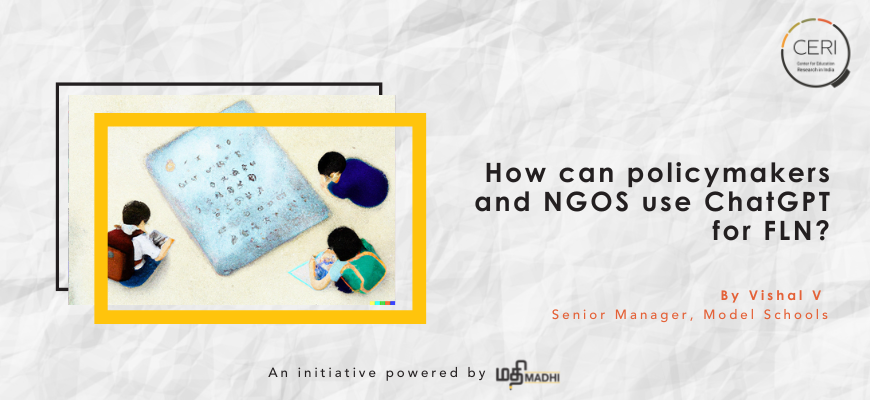
How can policymakers and NGOS use ChatGPT for FLN
This article is the first in a series of articles on how ChatGPT and AI models can be leveraged for FLN.
Governments can use GPT-3, or other artificial intelligence models, in a number of ways to improve learning outcomes for students:
- Generating educational materials: Governments can use AI models to generate
educational materials for foundational literacy and numeracy education. These materials
can be customised to meet the needs of individual students and can provide practice
opportunities that help students develop their skills. - Improving teacher productivity: Governments can use AI models to automate the
generation of educational materials and provide practice opportunities for students. This
can free up teachers’ time and allow them to focus on other aspects of their job, such as
individualised attention to students and assessment of their progress. - Personalising learning: AI models can be used to generate personalised educational
materials that meet the specific needs and abilities of individual students. This can help
to keep students engaged and motivated and can make the learning experience more
effective. - Supporting remote learning: Governments can use AI models to support remote
learning, which is becoming increasingly important due to the COVID-19 pandemic. AI
models can provide educational materials and practice opportunities for students who
are unable to attend traditional classes in person. - Providing real-time feedback: Governments can use AI models to provide real-time
feedback to students, helping to improve their literacy and numeracy skills. This
feedback can help students understand their strengths and weaknesses and target their
efforts more effectively. - Informing policy and decision making: Governments can use the data generated by AI
models to inform policy and decision making. This data can help to understand the
effectiveness of different teaching methods and identify areas where additional
resources or support may be needed. - Strengthening partnerships: Non-profits can use AI models to strengthen partnerships
with governments and other organisations, allowing them to collaborate more effectively
on initiatives aimed at improving education outcomes.
Parallely, there could be some issues, both for governments and non-profits working to improve learning outcomes in FLN.
- Quality control: The quality of educational materials generated by AI models may vary,
and there is a risk that inaccurate or inappropriate information may be presented to
students. This could negatively impact their learning and create confusion. - Bias: AI models can perpetuate and amplify existing biases in society. This could lead to
educational materials that are not inclusive or culturally sensitive, which could have a
negative impact on students’ learning experiences. - Dependence on technology: The use of AI models for foundational literacy and
numeracy education may make students overly dependent on technology and reduce
their motivation to engage in traditional learning activities. - Data privacy: The use of AI models for foundational literacy and numeracy education
may raise concerns about student data privacy and security. Governments and
educators must ensure that data is collected, stored, and used in a secure and
responsible manner. - Limited creativity and critical thinking: While AI models can generate educational
materials and provide practice opportunities, they may not be able to fully replace
human teachers and may not promote creative and critical thinking as effectively. - Cost: The development and deployment of AI models for foundational literacy and
numeracy education may be expensive, and governments must carefully consider the
cost-benefit of such initiatives. - Technical limitations: AI models such as GPT-3 are not perfect, and may not be able to
fully understand context and nuances in language, which could lead to
misunderstandings and mistakes in the educational materials they generate..
Our next articles in this series will look into how AI models can be leveraged to generate content for teaching FLN and also show samples of what kind of content can be generated.
This article was written with the help of ChatGPT.
Banner image courtesy: An AI generated image by DALL – E https://openai.com/dall-e-2/
This article was written under the aegis of the Centre for Education Research in India (CERI). CERI, an initiative powered by Madhi Foundation, is a digital repository and think-tank catering to policymakers, practitioners, and academics in the education sector and the larger community, to catalyse reform in the education ecosystem in India.
Vishal works as a Senior Manager for the Model Schools Project with the Government of Tamil Nadu. He's an alumnus of the Harvard Graduate School of Education and is an independent researcher at the intersection of caste, politics and education.
